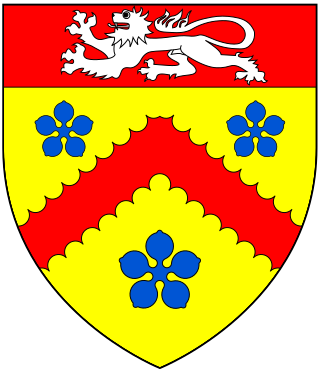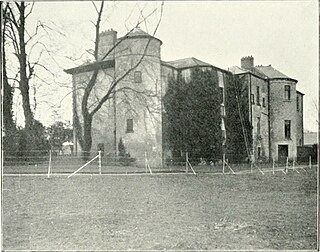Related Research Articles

Templeogue is a southwestern suburb of Dublin in Ireland. It lies between the River Poddle and River Dodder, and is about halfway from Dublin's centre to the mountains to the south.

Santry is a suburb on the northside of Dublin, Ireland, bordering Coolock, Glasnevin, Kilmore and Ballymun. It straddles the boundary of Dublin City Council and Fingal County Council jurisdictions.
Compton Domvile may refer to:
Sir Thomas Edward Winnington was an English Whig and Liberal politician who sat in the House of Commons in two periods between 1807 and 1837.

There have been three baronetcies created for persons with the surname Cooke, two in the Baronetage of England and one in the Baronetage of Ireland. One creation is extant as of 2013.
Sir Thomas Edward Winnington, 4th Baronet was an English Whig and Liberal politician.
There have been two baronetcies created for persons with the surname Burton, one in the Baronetage of England and one in the Baronetage of Ireland. Both creations are extinct.
The Poë, later Poë-Domvile Baronetcy, of Heywood in the Parish of Ballinakill in Queen's County, was a title in the Baronetage of the United Kingdom. It was created on 2 July 1912 for Hutcheson Poë, subsequently Lord Lieutenant of Queen's County (1920–22) and a Senator of the Irish Free State (1922–24). He married Mary Adelaide, only surviving daughter of Sir William Compton Domvile, 3rd Baronet. Through this marriage Heywood House came into the Poë family.

The Domvile Baronetcy, of Templeogue in the County of Dublin, was created in the Baronetage of Ireland on 21 December 1686 for Thomas Domvile, who represented Mullingar in the Irish House of Commons. He was the son of William Domville, son of Gilbert Domville, MP for Dublin, member of an ancient Cheshire family. The second Baronet was a member of the Irish Parliament for County Dublin. The title became extinct on his death in 1768. Sir William Domvile, brother of the first Baronet, represented Armagh and Dublin in the Irish Parliament. William Domville, elder brother of the aforementioned Gilbert Domvile, was the ancestor of the Domville baronets of St Alban's.
Henry Barry, 4th Baron Barry of Santry (1710–1751), often referred to simply as Lord Santry, was an Irish peer, who was a notorious rake. He is unique in being the only member of the Irish House of Lords to be convicted of murder by his peers, for which crime he was sentenced to death. He later received a full pardon for the murder but died abroad when he was still a young man.

Sir William Hutcheson Poë, 1st Baronet was an Irish soldier and politician.
John Pocklington (1658–1731) was an English lawyer and Whig politician who sat in the English and British House of Commons between 1695 and 1713. He was appointed a Welsh circuit judge in 1707 and a judge of the Court of Exchequer (Ireland) in 1714, as a result of which he settled in Ireland. He suffered from chronic ill health, and was imprisoned on the orders of the Irish House of Lords in 1719, during a major Constitutional crisis. His descendants, who adopted the surname Domvile, were wealthy landowners in Templeogue, south County Dublin.
Sir Compton Domvile, 1st Baronet of Templeogue and Santry House, County Dublin, was an Irish Member of Parliament in the United Kingdom parliament and Governor of County Dublin.
Lady Margaret Frances Domville was an Irish aristocrat and a writer. She was also the daughter of the 3rd Earl of Howth and the wife of Sir Charles Compton Domville, 2nd Bt.

Santry Court was a Georgian house and demesne in Santry, north County Dublin built between 1703-09 on the site of an earlier medieval residence.
Sir Compton Domvile, 2nd Baronet was an Anglo-Irish politician.
Sir Thomas Domvile, 1st Baronet was an Anglo-Irish politician.
Charles Domvile was an Anglo-Irish politician.
Sir Charles Compton was a Northamptonshire landowner, a Cavalier in the First English Civil War, and briefly an MP for Northampton after the Restoration.
References
- ↑ "No. 16969". The London Gazette . 27 December 1814. p. 2535.
- 1 2 "Domvile, Sir Compton, 1st Bt. (c.1775-1857), of Templeogue and Santry House, co. Dublin. History of Parliament Online". www.historyofparliamentonline.org.
- 1 2 3 Foster, Joseph (1882). The Peerage of the British Empire. Westminster: Nichols. pp. 184–185.
- ↑ "Domvile, Sir Compton Meadeu" . Who's Who . A & C Black.(Subscription or UK public library membership required.)
- Poë Name and Arms (Compton Domvile Estates) Act, 1936 Irish Statute Book